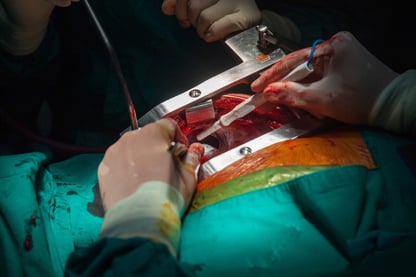Heart disease is the leading cause of death for both men and women, and about half of Americans have at least one risk factor. Half-a-million coronary bypass surgeries are performed each year in the US.
Open-heart surgery is a procedure where the chest needs to be opened to correct problems with the heart. Depending on the type of surgery, the surgeon may also have to open the heart. According to the National Heart, Lung, and Blood Institute (NHLBI), the most common heart surgery is the coronary artery bypass grafting (CABG)1 to treat severe coronary heart disease, which happens when plaque builds up inside the arteries.

In a CABG, a healthy artery or vein gets connected, or grafted, to the blocked coronary artery. This vein can be removed from the patient’s leg and then stitched to the aorta and coronary artery. Another method is to use the internal mammary artery and relocate it from the chest wall into the coronary artery. The grafted artery or vein goes around the blocked portion of the coronary artery, creating a bypass. A surgeon can bypass more than one blocked coronary artery during one surgery.2
While this is the most common way to treat coronary heart disease, there are many other surgeries performed to treat this and other heart conditions. The most notable are:
- Transmyocardial Laser Revascularization (TMR) – This procedure is usually performed to treat angina when no other treatments work. A small incision is done in the chest to expose the heart muscle, and a high-energy laser is used to make one millimeter wide channels inside the heart. The outer areas of the channels are closed, but the inner ones remain open to improve blood flow. It isn’t fully understood how TMR works, but there is evidence this surgery helps the heart grow tiny new blood vessels, which relieve angina.3
- Heart Valve Repair or Replacement – In most cases, this is an open heart operation. The surgeon opens the chest and heart to remove a damaged valve and a prosthetic one is sewn into place. There are some cases where the valve can be replaced through a small incision near the breastbone, making the surgery a minimally invasive one.4
- Heart Transplant – This type of surgery removes the patient’s diseased heart and replaces it with a healthy heart from a deceased donor. This operation is for patients who have end-stage heart failure, or for people whose heart is very damaged and weak.5
- Arrhythmia Treatment – Although many arrhythmias are harmless, some can be serious and even life threatening. An abnormal heart rate may not pump enough blood to the body, and it may damage the brain and other organs in the body. Some arrhythmias are treated with a pacemaker – a small device that gets placed under the skin of your chest. This device sends electrical pulses to help the heart beat at a normal rate. Another way to treat arrhythmias is an implantable cardioverter defibrillator (ICD). This device is also placed under the skin of your chest and uses electrical pulses to control arrhythmias. The ICD monitors the heart continuously, if it senses a dangerous arrhythmia, it sends an electric shock to the heart to restore it.6
- Aneurysm Repair – An aneurysm is a bulging or an out-pouching portion of a blood vessel. It can occur anywhere in the body, but it is particularly dangerous if it occurs in the aorta. This may happen when the artery wall weakens, and the blood moving through the artery makes the weak area An aneurysm can burst and cause fatal bleeding inside the body, hence repair surgery is performed prophylactically. The dilated part of the vessel gets removed and replaced with a graft, or synthetic material that won’t break.7
- Angioplasty – This minimally invasive procedure is used to widen narrowed or obstructed arteries or veins. A deflated balloon is attached to a catheter, passed over a guide-wire into the narrow vessel, and then inflated to a fixed size. Sometimes, a stent is inserted to make sure the vessel remains open, then the balloon gets deflated and removed.8
- Cardiomyoplasty – This surgical procedure takes healthy muscle from another part of the body, usually the latissimus dorsi from the patient’s back; and then it gets wrapped around the heart to provide support. A special pacemaker is also inserted to make the skeletal muscle contract.9
- Minimally Invasive Heart Surgery – Is performed to do some bypass, heart valve replacement, insert pacemakers, or use another vein or artery from the body to use it as a graft. As it name suggests, the chest is not cut open, but rather small incisions are made in the right side of the chest, and the surgeon operates between the ribs. The patient experiences less pain and quicker recovery, while it also gives the surgeon a better view of some portions of the heart versus an open-heart surgery.10
Sklar offers a comprehensive selection of high-quality cardiovascular instruments. You may browse through these by clicking the button below.
References:
1 Phillips, Natalie; Gotter, Ana, Open Heart Surgery. (September 2016)
2 Heart Surgery. (National Heart, Lung and Blood Institute, November 2013)
3 Treating Inoperable Heart Disease: TMR (MedicineNet.com)
4 Surgery: What to Expect – Heart Valve Replacement. (Medtronic.com)
5 Heart Transplant. (National Heart, Lung and Blood Institute, December 2016)
6 How Are Arrhythmias Treated? (National Heart, Lung and Blood Institute, July 2011)
7 What is an aneurysm and why is it important? (Johns Hopkins Heart & Vascular Institute)
9 Cardiac Procedures and Surgeries. (Heart.org, July 2015)
10 Minimally invasive heart surgery. (MayoClinic.org)



